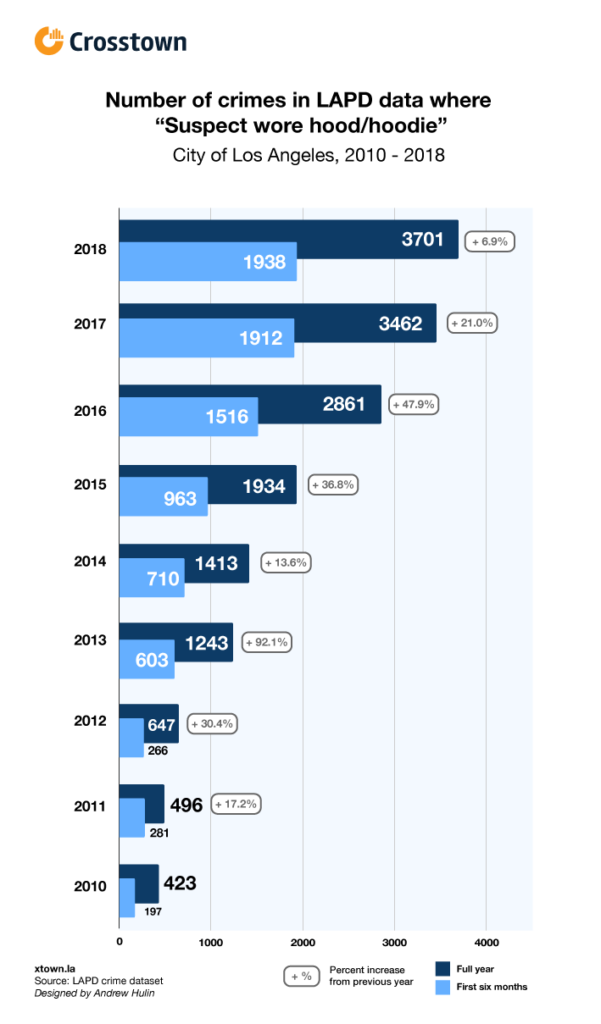‘Suspect wore a hoodie’

For a piece of clothing, the hoodie carries a lot of baggage.
The hooded sweatshirt has been at the center of heated debates about racial profiling, most famously following the 2012 shooting death of unarmed black teenager Trayvon Martin.
George Zimmerman, the neighborhood watch coordinator who fatally shot Martin in the gated Sanford, Fla., neighborhood, had described him as wearing a “dark hoodie, like a grey hoodie” to police on the phone before pursuing Martin.
In the City of Los Angeles, the hoodie appears in Los Angeles Police Department crime data to describe what suspect or suspects were wearing at the time of a reported crime: “Suspect wore hood/hoodie.”
The department has been cataloging this clothing descriptor for suspects since at least 2010, when it started making its data publicly available.
But in the year following Martin’s death, the number of crimes reported with “Suspect wore hood/hoodie” skyrocketed. In 2013, there were 1,243 reports, a 92% increase from 2012.
While this was the largest jump since 2010 (when the data became publicly available), the data show the number of suspects being labeled as wearing hoods or hoodies rising each year.
This year, in the first six months, there were 2,510 crimes with “Suspect wore hood/hoodie,” a 29.5% increase from the first six months of 2018, which had 1,938 reported crimes.

Hoodies recently made national news again when former Vice President and presidential hopeful Joe Biden said, “We’ve got to recognize that kid wearing a hoodie may very well be the next poet laureate and not a gangbanger.”
This isn’t about a hoodie. It’s about a culture that sees a problem with a kid wearing a hoodie in the first place. Our nominee needs to have the language to talk about race in a far more constructive way. https://t.co/c2BFSSOHro
— Cory Booker (@CoryBooker) June 28, 2019
The LAPD’s code for “Suspect wore hood/hoodie” is one of many identifiers it uses to describe what a suspect wore. Other items listed in the LAPD 2019 data entry code manual under “Suspect Wore/Disguise” include “Cap/hat,” “Wig” and even “Mustache- Fake.”
But hoodies get the most mentions.
“We have not done a study on those numbers, or the increase,” said LAPD spokesperson Officer Drake Madison. “Therefore we do not have someone who will be able to speak on them.”
The LAPD does not provide publicly available data on race or ethnicity information for suspects.

Crimes by suspect attire* in LAPD data
City of Los Angeles
2010 – 2018
- Suspect wore hood/hoodie: 16,180
- Cap/hat: 13,382
- Gloves: 1,633
- Mask: 987
- Handkerchief: 840
- Ski mask: 766
- Bag: 270
- Nude/partly nude: 233
- Suspect wore disguise: 198
- Uniform: 177
- Clothes of opposite sex: 100
- Wig: 98
- Suspect wore motorcycle helmet: 76
- Unusual clothes: 73
- Halloween mask: 68
- Cloth (with eyeholes): 56
- Earring: 54
- Stocking: 32
- Shoes: 28
- Mustache- Fake: 19
- Make up (males only): 18
*These are the exact phrases the LAPD lists under “Suspect Wore/Disguise” in its 2019 data entry code manual.
How we did it: We looked at publicly available LAPD data on reports of crime labeled with “Suspect wore hood/hoodie” from Jan. 1, 2010 (the earliest date available in the data) – June 30, 2019. For neighborhood boundaries, we rely on the borders defined by the Los Angeles Times. Learn more about our data here.
LAPD data only reflects crimes that are reported to the department, not how many crimes actually occurred. On occasion, the LAPD may update past crime reports with new information, or recategorize past reports. Those revised reports do not always automatically become part of the public database.
Want to know how your neighborhood fares? Or simply just interested in our data? Email us at askus@xtown.la.






